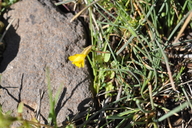Taxon Report
Erythranthe inflatula (Suksd.) G.L. Nesomephemeral monkeyflower |
 © 2020 Dean Wm. Taylor |
Taxon Summary
Erythranthe inflatula, commonly known as ephemeral monkeyflower, is a annual herb in the Phrymaceae that is found in California and elsewhere. It occurs within Great Basin scrub, Lower montane coniferous forest, and Pinyon and juniper woodland, growing at elevations from 1250 to 1740 meters. Erythranthe inflatula is ranked 1B.2, Plants Rare, Threatened or Endangered in California and Elsewhere; Moderately threatened in California.Classification
|
Scientific Name: |
Erythranthe inflatula (Suksd.) G.L. Nesom |
|
Common Name: |
ephemeral monkeyflower |
| Family: | Phrymaceae |
| Element Code: | PDSCR1B370 |
| USDA Plants Symbol: | |
|
Synonyms/Other Names: |
|
Ecology and Life History
| Lifeform: | annual herb |
| Blooming Period: May-Aug | May-Aug |
| Elevation: | 1250-1740 (4100-5710) |
| General Habitats: | Great Basin scrub, Lower montane coniferous forest, Pinyon and juniper woodland |
| Microhabitat: | Gravelly (sometimes), Rocky (sometimes), Vernally Mesic |
| Microhabitat Details: |
Conservation Status
| CA Rare Plant Rank: | 1B.2 |
| Global Rank: | G3 |
|
State Rank: |
S2 |
| State List: | None |
| Fed List: | None |
| Other Status: | BLM_S; USFS_S |
|
CRPR Changes: |
|
Occurrence Data from the CNDDB
| Total Occurrences: | 26 |
| Element Occurrence Ranks: | |
| Excellent (A) | 2 |
| Good (B) | 9 |
| Fair (C) | 3 |
| Poor (D) | 5 |
| None (X) | 1 |
| Unknown (U) | 6 |
| California Endemic: False | |
| California Counties and Islands: Name (Code) | |
| Lassen (LAS), Modoc (MOD), Shasta (SHA), Siskiyou (SIS)* | |
| Quads: Name (Quad Code) | |
| Bray (4112168), Champs Flat (4012068), Corders Reservoir (4012172), Crank Mountain (4112142), Davis Creek (4112063), Donica Mtn. (4112132), Lane Reservoir (4112017), Lauer Reservoir (4112064), Letterbox Hill (4112018), Likely (4112025), Lookout (4112122), McDonald Peak (4012084), McGinty Reservoir (4112075), Perez (4112163), Poison Lake (4012162), Snowstorm Mtn. (4012063), South Mtn. (4112076), Spalding Tract (4012067), Spaulding Butte (4112152), Straylor Lake (4012171), Sugar Hill (4112073), Swains Hole (4012163) | |
Threat List Data from the CNDDB
| Threat List Total: | 6 | |
| EOs with Threat Listed: | Total EOs | % of EOs |
| 15 | 58 % | |
| Grazing | 11 | 42% |
| Foot traffic/trampling | 7 | 26% |
| Road/trail construction/maint. | 2 | 7% |
| Insufficient population/stand size | 1 | 3% |
| Non-native plant impacts | 1 | 3% |
| Recreational use (non-ORV) | 1 | 3% |
Notes
| Possibly threatened by trampling and hydrological alterations. On review list in ID, and candidate for state listing in OR. Similar to E. breviflora; possibly a hybrid between E. breviflora and E. latidens. See Great Basin Naturalist 55(3):250 (1995) for original description, Phytoneuron 2012-39:1-60 (2012) for revised nomenclature, and Phytoneuron 2012-41:1-36 (2012) for taxonomic treatment. |
|
Threats: |
|
Taxonomy: |
Selected References
| Erythranthe inflatula profile for potential Species of Conservation Concern evaluation (2017) |
Citation
California Native Plant Society, Rare Plant Program. 2025. Rare Plant Inventory (online edition, v9.5.1). Website https://www.rareplants.cnps.org [accessed 18 December 2025].